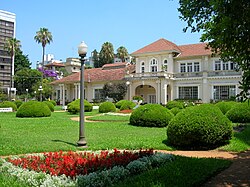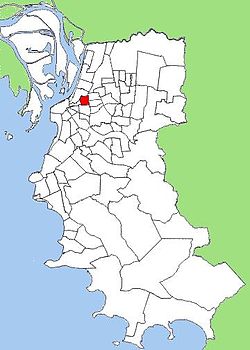Moinhos de Vento
Moinhos de Vento | |
|---|---|
Bairro | |
 The Hidráulica Moinhos de Vento and its gardens | |
 Moinhos de Vento within Porto Alegre | |
| Country | |
| State | Rio Grande do Sul |
| City | Porto Alegre |
Moinhos de Vento (literally Windmills in English) is a neighbourhood of the city of Porto Alegre, the state capital of Rio Grande do Sul in Brazil. It was created by Law 2022 of December 7, 1959.
Moinhos de Vento received this name because Azorean immigrant families constructed their windmills in its area, during the 18th century. As a matter of fact, wheat production was an important economic enterprise in the then-village of Nossa Senhora de Madre de Deus, nowadays called Porto Alegre.
In 1893, tramcars lead to the development of Moinhos de Vento, where rich and traditional families built their residences. Many of them were business, industrial and political personalities, not only from the city, but also from the state. In 1894, the Independência hippodrome was installed here and horse racings became very popular until the arrival of football. After the hippodrome was transferred to another place, the Moinhos de Vento Park was inaugurated in the site.
Still an upper middle class and upper class area of Porto Alegre, Moinhos de Vento is well-served by bars, restaurants and luxury stores.
Also, there is located a highly regarded and traditional private school of the city, the Nossa Senhora do Bom Conselho school, well known as the Bom Conselho.
About childhood education, Moinhos de Vento has two highly regarded private schools, the Lar do Bebê-Pupileira and Gente Miúda schools.
External links

